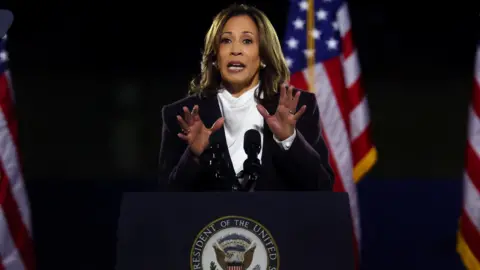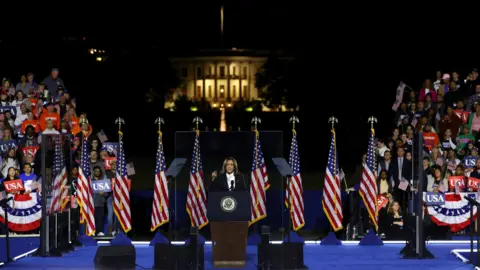 Reuters
ReutersThe night before Kamala Harris sets off on a final multi-day swing through the key battleground states that will decide the 2024 presidential election, she gave one last speech, practically in the shadow of the White House.
The venue choice was no accident. Donald Trump held his rally on 6 January 2021 in the same place, speaking to supporters just hours before thousands of them stormed the Capitol and disrupted certification of Joe Biden’s presidential victory.
On a mild October night, Harris stood before what her campaign estimated was 70,000 cheering supporters at an event they may hope is a counterpoint to that cold, violent January day.
And in the unlikely chance the symbolism was missed by anyone watching, Harris made it explicit early in her speech.
“We know who Donald Trump is,” she said on Tuesday. “He is the person who stood at this very spot nearly four years ago and sent an armed mob to the United States Capitol to overturn the will of the people in a free and fair election.”
Harris didn’t dwell on the 6 January riot, however. The venue did most of the heavy lifting, providing the subtext to the speech and the point from which Harris could pivot.
While she opened by darkly warning of an “unstable” and “unhinged” Trump “obsessed with revenge”, she turned to focus on what she called her “different path”.
Acknowledging that many undecided American voters “are still getting to know” her after her abbreviated presidential campaign, Harris touched on the highlights of her biography and upbringing.
She went on to hit some of her top policy proposals, including lowering the cost of housing, expanding the child tax credit and adding homecare coverage to government-provided health insurance for the elderly.
She spent even more time talking about abortion and the need to enact legislation that provides national abortion rights – a particularly strong area for Democrats over Republican opponents.
It was, in effect, a trimmed-down version of her Democratic National Convention address – a bookend to the late August speech that the campaign billed as an introduction to Americans.
Democrats were riding high back then, enthusiastic about their new nominee after weeks of despondency and infighting that led to Biden’s decision to abandon his re-election bid.


 Reuters
ReutersSince then, Harris’s campaign has had ups and downs, and is now locked in what is shaping up to be a photo finish next week.
If the polls are accurate, Harris still has work to be done to win over undecided Americans – and this speech was her last, biggest effort to do so on a prominent stage, with the White House looming over her shoulder.
Setting aside her biographical highlights and policy details, the message her campaign seems to want voters to have in mind on election day is one of contrasts – of division versus unity; bitterness versus hope; partisanship versus co-operation; past versus future.
“I pledge to seek common ground and common sense solutions to make your lives better,” Harris said. “I am not looking to score political points. I am looking to make progress.”
As she was delivering her speech, however, the current resident of the building behind her made comments that illustrated how difficult her task might be.
Biden, speaking of a derisive joke about Puerto Rico that a comedian made at a Trump rally on Sunday, appeared to refer to Trump supporters as “garbage”.
The president later claimed he was referring only to the comments made by the rally speaker. But the video of his remarks are unclear – and the episode was already distracting from Harris’ event on Tuesday evening.
It’s just one more obstacle Harris will have to overcome, along with assuaging Americans’ concerns about the economy and immigration – where polls indicate Trump has the advantage.
She tried to address those in her speech as well, even if they seemed to take a back seat to more lofty language and pointed attacks.
Her speech framed the election in a way that is to her advantage. Next Tuesday will reveal whether a majority of the American public – or at least a plurality in enough key battleground states – agrees.

North America correspondent Anthony Zurcher makes sense of the race for the White House in his twice weekly US Election Unspun newsletter. Readers in the UK can sign up here. Those outside the UK can sign up here.


